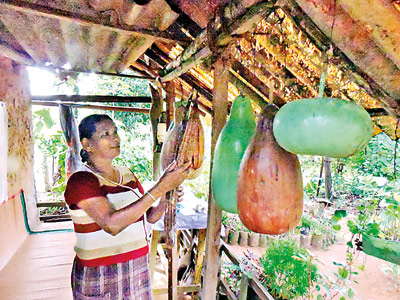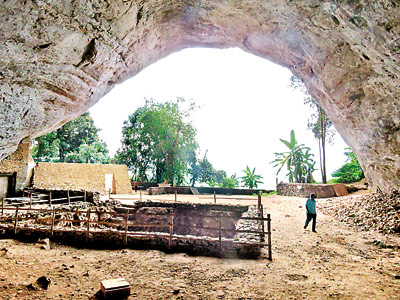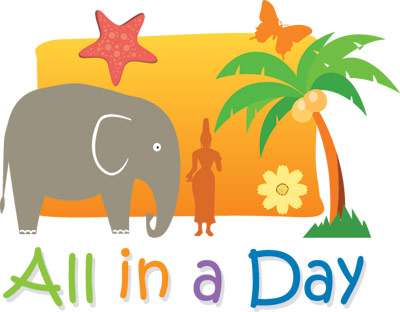Fruity haven to historic cave; not far from Colombo
View(s):
Dhananjani Silva visits many an interesting site on a trip to Horana and Bulathsinhala. Bountiful yield: A woman shows the produce from a home garden at the Research Institute
This time in our ‘All In A Day Travel Series’ we set off on the road less travelled heading to Horana and Bulathsinhala, in the Kalutara District.
We took off early morning, on the Colombo Horana main road, enjoying the quintessentially pastoral views of lush green paddy fields, tea and rubber estates with villagers going about their daily errands – farmers in the field, rubber tappers, fishmongers, bullock carts all livening up this unspoiled natural beauty.
Horana and Bulathsinhala are just one and half hour’s journey from Colombo and have many interesting attractions to explore, as we soon discovered.
Going into the interior, to both these destinations can be somewhat confusing but if your directions are not all that clear, ask a villager. Also, make sure you pack enough water and food for your journey; fancy dining options are not found here.
If you are inclined to a traditional village meal, then the roadside boutiques are worth stopping by. To quench your thirst, pop into a small wayside kiosk serving tea or king coconut.
Our first stop was at the Fruit Research and Development Institute in Kananwila – which is under the purview of the Agriculture Department that engages in crop research, crop establishment evaluation and development.
A massive fruit plantation that spreads across about 150 acres, with its varieties of fruit – from pineapples, dragon fruit, mangoes, to banana, mangosteens and lemons, is beautiful to see.

Pahiyangala: The most important pre-historic site in the country
The place is open for inspection, by appointment. Many students, undergrads and teachers visit the place to see the various fruits, home gardening methods, crop development and cultivation methods while farmers come here to seek instructions and advice on fruit cultivation, tissue culture, planting tips etc.
At the entrance is a sales outlet where the excesses of the day’s fruit crop which is not used for research, is sold. As quality seasonal fruits can be bought here at a reasonable cost, villages come here as early as 8 a.m. to buy the fruits.
The traditional Mask Village in Pokunuwita is also worth a visit, especially if you fancy taking back a souvenir or two to from your journey.
Located in Bandarawatte – in close proximity to Pokunuwita, one of the main towns in Horana, (about two kilometres from Horana town) the village has several families engaged in making traditional masks as a cottage industry.
Watching the art of making traditional masks- from cutting the wood to carving and painting- can be an interesting experience too.
In Pokunuwita look out for the historic Kithsiri Mewan Raja Maha Viharaya –popularly known as the Galey Pansala as the temple is placed at different elevations on a rock cliff.
There is no clear evidence of the origin of this temple, yet an inscription found here suggests a donation made by Deva- the son of a Minister who served under King Kithsiri Mevan in 4th Century AD.
Climb up the rock steps and you will find a beautiful natural pond. The folklore connected to this pond has it that there is a about a four kilometre long underground tunnel running from this point on, up to a temple in the adjacent village Rigama.
Continue your journey from Pokunuwita to Horana and on your left, on a hillock stands a beautiful church. A Calvary shrine and a church dedicated to Saint Martin de Porres, it was built in 1910.
With its 14 points depicting the Way of the Cross, devotees visit to follow the Way of the Cross during the season of Lent, explains the priest.
Designed by the famous architect, Valentine Gunasekara, the Church is built in the style of an eagle. Horana being a missionary area back in the day, the idea behind the design was to imply that, similar to the eagle that flies far and wide, missionary activities too spread all around.
Next we headed to Bulathsinhala- some 20 km from Horana. The village Yatagampitiya is a popular location amongst visitors to Bulathsinhala.
This is where the famous Fa- Hsien cave (Pahiyangala) the most important pre historic cave discovered in Sri Lanka so far, dating back to over 30,000 years is located. From the Bulathsinhala main town, it is about seven km and there are plenty of sign boards along the way.
At the foot of the hill is a visitor information centre and a Buddhist temple. When we visited it was evening and a caretaker at the temple told us that we would have to climb the rock as there is no motorable road from that point onward.
We cut across the grove filled with rare plants such as akkapana, bandura, wallpatta, kitul, and took the rocky path to reach the top of the cave.
The main cave is said to have been first excavated in 1986. Excavations on this site revealed pre historic habitation belonging to the Mesolithic period. Also during excavations a complete human skeleton had been discovered.
It was believed that the Chinese Buddhist monk Fa-Hsien, took shelter in this cave during his journey to Adam’s Peak.
The swamp forest Waluwwewatta Waturana is another interesting location in Bulathsinhala. This is found in the Galketiya Kanda area close to Pahiyangala.
Located in a private property, it has been gazetted as an environmentally protected area, as it is a unique habitat for the plant Horawel (Stemnoporus mooni ) and Suwanda- Mesua stylosa.
The habitat is also home to rare, critically endangered animals, birds and reptiles.
The forest area which borders a few waterways gets periodically inundated during the rain; hence avoid the rainy season. Beware of leeches too as you walk into the deep forest.
Inspection tours to the site can be pre-arranged by contacting the Estate’s Superintendent’s office on 0773551985.
If you do go to the Superintendent’s office, do not forget to check out the small shed opposite for if you are lucky enough, you would have the opportunity to see the Cinnamon peelers at work here.
Another discovery we made in Bulathsinhala was the temple murals at the Bulathsinhala Maha Pansala (also known as Sri Devam-ittarama temple). An archaeologically protected site, the temple’s main shrine has Kandy period architecture while in the inner chamber you find murals influenced by the same period.
A monk at the temple who took us around says red and black background used for the paintings, the borichchi jacket styles of the female figures in the murals, the sun and the moon symbols which is essentially a Kandy period painting tradition, are evidence of Kandy /Gadaladeniya period artistic influence.
Next was the visit to the Etabella stream- a natural waterway found in Udugalakanda Delmella. Only the gurgling stream and animal sounds can be heard in this tranquil place.But on weekends it is quite a popular bathing spot, packed with visitors.


